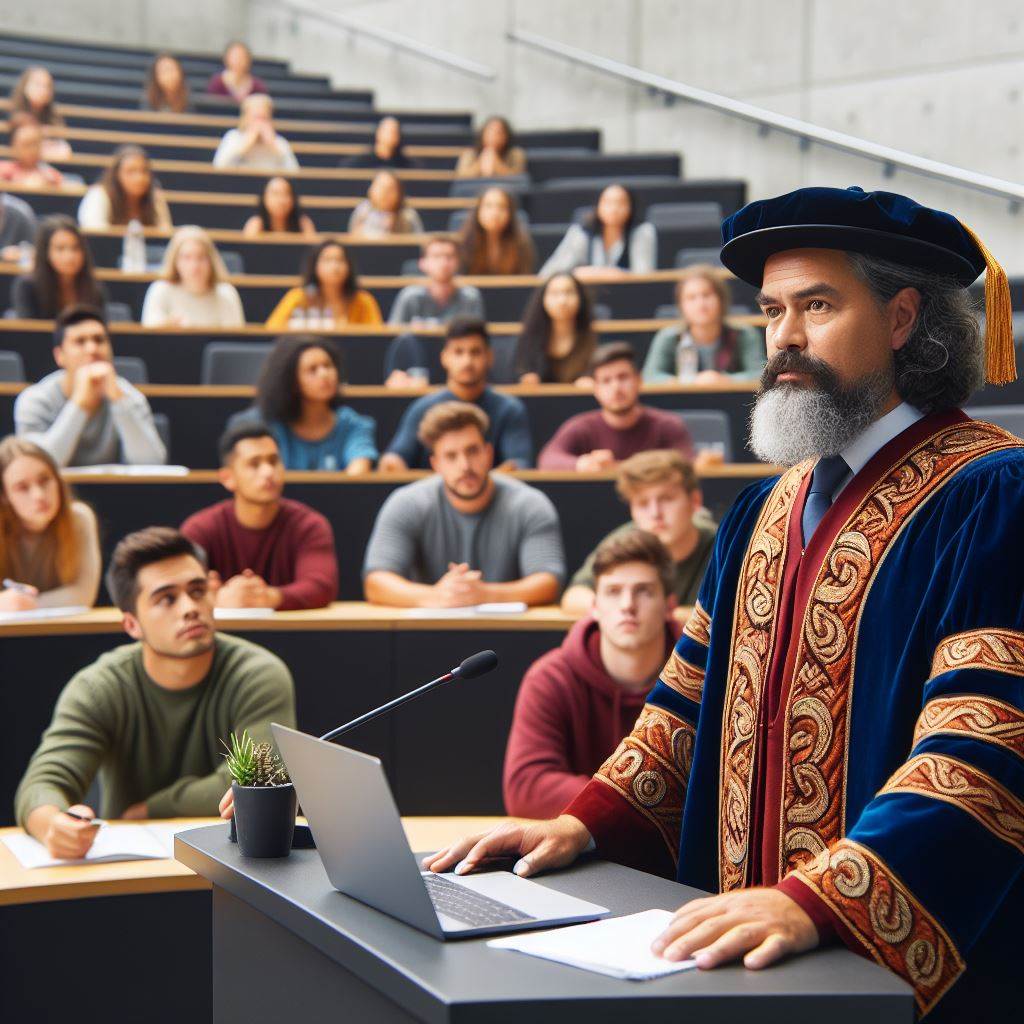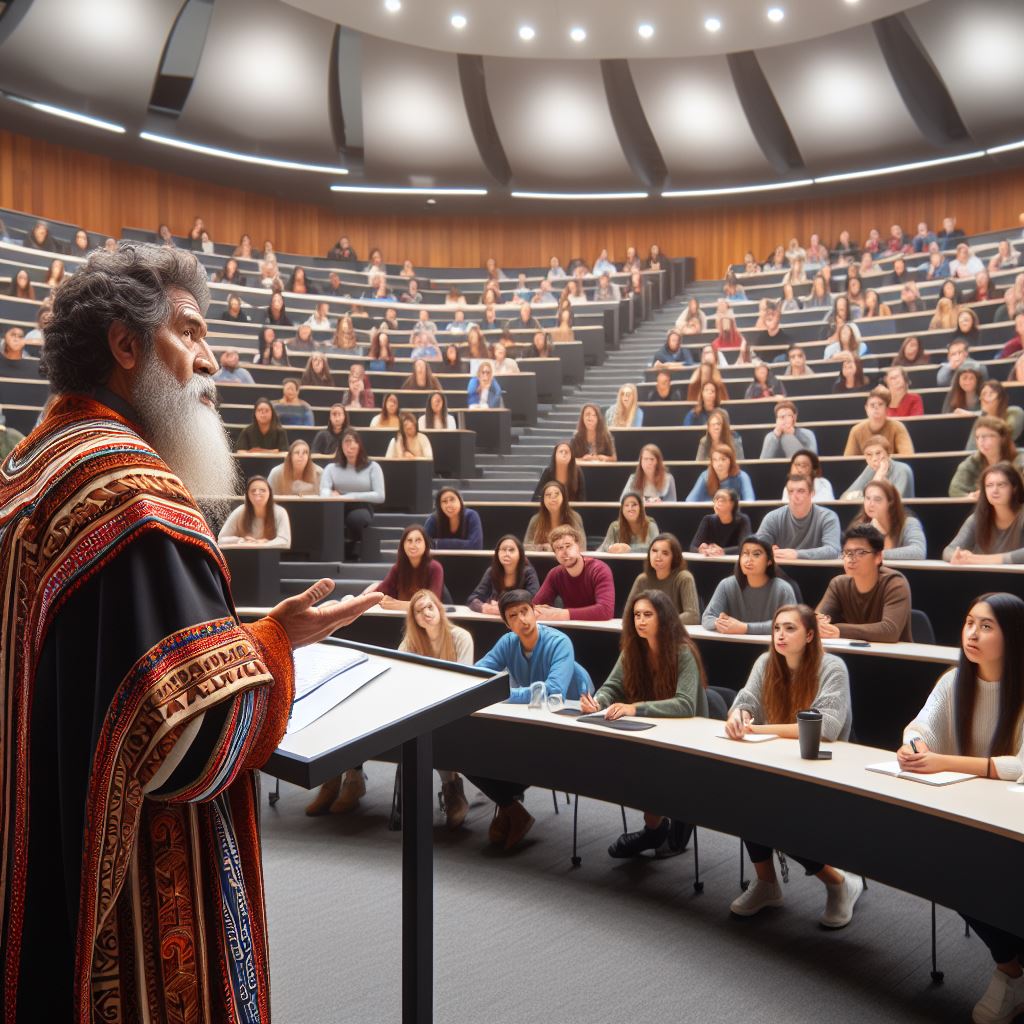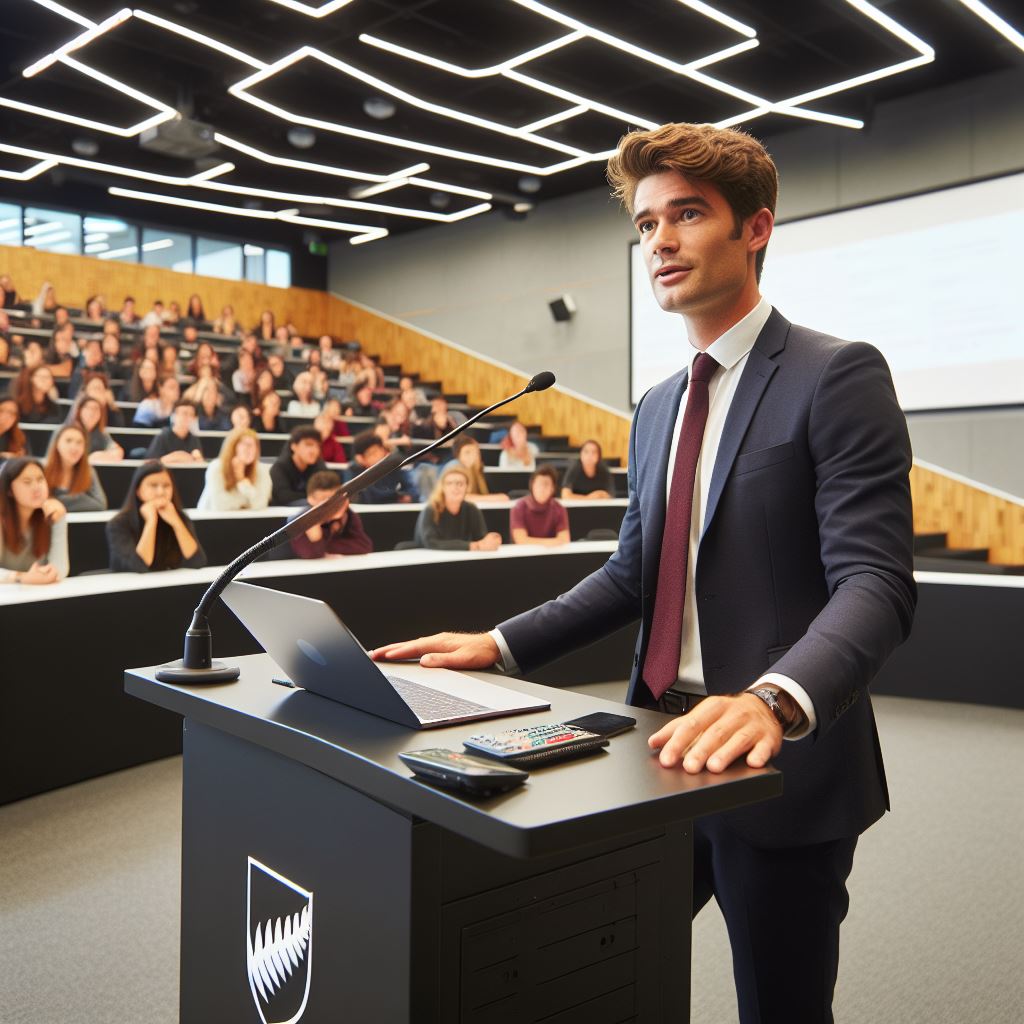Introduction
Teaching methods play a crucial role in university education, shaping the learning experiences of students. In New Zealand, top university lecturers have a significant impact on students’ educational journeys.
Importance of teaching methods in university education
Teaching methods are vital as they determine how knowledge is imparted to students, influencing their understanding and retention of information.
Effective teaching methods enhance student engagement, critical thinking, and problem-solving abilities.
Overview of top NZ university lecturers and their impact on students’ learning experiences
Top university lecturers in New Zealand employ innovative teaching methods to create a conducive learning environment.
They utilize active learning techniques, such as group discussions, case studies, and hands-on activities, to enhance student participation.
These lecturers understand the diverse learning needs of their students and incorporate various teaching strategies accordingly.
They prioritize student-centered approaches, encouraging collaboration, and fostering a sense of ownership over their learning.
Furthermore, top NZ university lecturers utilize technology effectively, integrating multimedia resources and online platforms to supplement traditional teaching methods.
They aim to create an interactive and dynamic learning experience for students, promoting self-directed learning and critical inquiry.
The impact of these teaching methods on students is profound.
Students experience increased motivation, improved comprehension, and higher levels of academic achievement.
They develop essential skills such as analytical thinking, problem-solving, and effective communication.
Basically, teaching methods hold immense significance in university education.
Top NZ university lecturers employ innovative techniques, creating an engaging and interactive learning environment that enhances students’ educational experiences.
Characteristics of Effective Teaching Methods
Clear communication and organization of course materials are essential in effective teaching methods.
Lecturers at top NZ universities understand the importance of presenting information in a concise and structured manner.
They also incorporate active learning techniques to engage students in the learning process.
By encouraging participation and hands-on activities, students are able to better understand and retain information.
Another characteristic of effective teaching methods is the ability to adapt to diverse learning styles.
Top NZ university lecturers recognize that not all students learn the same way and strive to provide different approaches to accommodate individual needs.
Furthermore, encouraging critical thinking and problem-solving skills is a key aspect of effective teaching methods.
Lecturers aim to foster a culture of inquiry and analysis where students can develop their analytical abilities and think critically about various concepts.
Clear Communication and Organization of Course Materials
Clear communication and organization of course materials lay the foundation for effective teaching.
Top NZ university lecturers carefully plan their lectures and deliver information in a structured manner, ensuring that students can easily follow along.
By using clear language and avoiding jargon, lecturers make complex concepts accessible to students.
They provide clear explanations, examples, and visual aids to support students’ understanding.
In addition, top lecturers organize their course materials in a logical sequence, making it easier for students to navigate through the content.
They provide a syllabus with clear objectives, assignments, and due dates, ensuring that students know what is expected of them.
By maintaining clear communication and organization of course materials, lecturers set students up for success and create a conducive learning environment.
Incorporation of Active Learning Techniques
Engaging students through active learning techniques is another hallmark of effective teaching methods.
Top NZ university lecturers understand that passive listening and note-taking are not sufficient for deep learning.
These lecturers incorporate a variety of active learning techniques, such as group discussions, case studies, simulations, and hands-on activities.
By actively involving students in the learning process, lecturers promote deeper understanding and critical thinking.
In active learning settings, students have the opportunity to apply their knowledge, collaborate with peers, and reflect on their learning.
This approach helps students retain information better and enhances their overall learning experience.
Adaptation to Diverse Learning Styles
Recognizing and accommodating diverse learning styles is crucial to effective teaching methods.
Top NZ university lecturers acknowledge that students have different preferences and strengths when it comes to learning.
They strive to present information in various formats and offer different resources to cater to different learning styles.
Lecturers may use visual aids, videos, hands-on activities, or provide supplementary materials to support students’ learning.
Moreover, lecturers encourage students to actively communicate their learning needs and preferences.
By creating an inclusive and supportive learning environment, top lecturers ensure that all students have equal opportunities to succeed.
Encouragement of Critical Thinking and Problem-Solving Skills
Developing critical thinking and problem-solving skills is a fundamental aspect of effective teaching methods.
Top NZ university lecturers go beyond simply delivering information; they challenge students to think critically and analyze concepts.
They engage students in discussions and activities that provoke thoughtful reflection and inquiry.
By asking open-ended questions and providing real-world examples, lecturers encourage students to apply their knowledge and develop problem-solving skills.
Top lecturers also provide constructive feedback on assignments and encourage students to critically evaluate their own work.
This helps students develop a growth mindset and the ability to assess and improve their performance.
Overall, effective teaching methods exhibited by top NZ university lecturers encompass clear communication and organization, active learning techniques, adaptation to diverse learning styles, and the encouragement of critical thinking and problem-solving skills.
These characteristics contribute to a positive and enriching learning experience for students.
Read: Salary Trends for NZ Edu Experts
Case Study: Professor Siouxsie Wiles from University of Auckland
Introduction to Professor Siouxsie Wiles and her teaching reputation
Professor Siouxsie Wiles is a highly esteemed educator at the University of Auckland, known for her innovative teaching methods.
Description of her teaching methods
With a reputation for engaging her students and fostering a genuine passion for learning, Professor Wiles leads by example, always striving for excellence in her teaching.
Use of multimedia resources to engage students
One of the key elements of Professor Wiles’ teaching approach is the use of multimedia resources to supplement her lectures.
By incorporating videos, images, and interactive tools, she captivates her students’ attention and enhances their understanding of complex concepts.
Incorporation of real-world examples and case studies
Furthermore, Professor Wiles is renowned for her ability to connect academic theories to real-world examples.
She brings in case studies from various industries and applies them to the subject matter, enabling her students to see the practical applications of what they are learning.
Encouragement of class discussions and student participation
Professor Wiles believes in the power of fostering classroom discussions and encouraging active student participation.
She creates a comfortable and inclusive environment where students feel comfortable sharing their thoughts and engaging in meaningful conversations about the subject matter.
Regular formative assessments and feedback
As part of her teaching philosophy, Professor Wiles emphasizes the importance of regular formative assessments and feedback.
She understands that continuous assessment allows students to monitor their progress and identify areas for improvement.
By providing timely and constructive feedback, she helps her students grow both academically and personally.
Personalized Career Consulting
Unlock your potential with expert career advice tailored to your goals. Get personalized guidance and actionable steps toward your dream career in New Zealand.
Get StartedPositive outcomes and student testimonials
The positive outcomes of Professor Wiles’ teaching methods are evident in the testimonials of her students.
They consistently praise her ability to make complex topics accessible and her dedication to their success.
Many students credit Professor Wiles with sparking their interest in the subject and motivating them to pursue further studies or careers in related fields.
All in all, Professor Siouxsie Wiles’ teaching methods at the University of Auckland are highly effective in engaging students and facilitating their learning.
Through the use of multimedia resources, real-world examples, class discussions, formative assessments, and feedback, she creates a dynamic and supportive learning environment.
The positive outcomes experienced by her students are a testament to her exceptional teaching abilities.
Read: Interviews with Leading NZ Educators
Case Study: Professor James Belich from University of Otago
Introduction to Professor James Belich and his teaching reputation
Professor James Belich is a highly esteemed lecturer at the University of Otago, renowned for his innovative teaching methods and remarkable reputation in the field of academia.
Emphasis on interactive lectures and demonstrations
Professor Belich, with his extensive experience, applies a variety of teaching techniques to engage his students actively. His interactive lectures and demonstrations form the foundation of his teaching approach.
Integration of technology for enhanced learning experiences
Utilizing technology is one of the key elements Professor Belich integrates into his teaching.
He believes that incorporating technology into the classroom enhances the learning experience by allowing students to access a wider range of resources and information.
Application of active learning strategies, such as group projects and problem-solving activities
Active learning strategies play a vital role in Professor Belich’s teaching methods. He frequently assigns group projects and problem-solving activities, encouraging students to collaborate and think critically.
Promotion of independent thinking and research skills
An aspect that sets Professor Belich apart is his promotion of independent thinking and research skills. He believes that students should have the opportunity to explore their own ideas and develop their analytical abilities.
Positive outcomes and student testimonials
The outcomes of Professor Belich’s teaching methods have been overwhelmingly positive. Many students have testified to the effectiveness of his techniques and their impact on their overall learning experience.
One student, Sarah Thompson, said, “Professor Belich’s interactive lectures kept me engaged and motivated to learn. I appreciated the use of technology and how it made complex concepts easier to understand.”
Another student, John Watson, added, “The group projects and problem-solving activities allowed us to apply our knowledge in a practical way. It really improved my critical thinking skills.”
In a nutshell, Professor James Belich from the University of Otago employs various teaching methods to create an engaging and effective learning environment.
Through interactive lectures, integration of technology, active learning strategies, and promotion of independent thinking, he fosters an atmosphere of intellectual growth and development.
The positive outcomes and testimonials from students attest to the success of his approach, making him a highly respected and revered educator.
Read: Edu Consultancy: Tech & Innovation

Comparison of Teaching Methods
Similarities in the teaching approaches of top NZ university lecturers
- Active learning: Lecturers encourage student participation through discussions and group activities.
- Interactive technology: The use of multimedia tools and online platforms enhance student engagement.
- Problem-based learning: Lecturers present real-world scenarios to promote critical thinking and problem-solving skills.
- Assessment variety: Lecturers employ a mix of assignments, quizzes, and presentations to evaluate students’ understanding.
- Interdisciplinary approach: Lecturers integrate different subject areas to create a holistic learning experience.
Differences in preferred strategies and techniques
- Lecturing: Some lecturers prefer a traditional approach, delivering information through structured lectures.
- Flipped classroom: Others adopt a flipped classroom model, where students learn the content independently and engage in activities during class time.
- Cooperative learning: Lecturers encourage collaboration among students to promote teamwork and peer-to-peer learning.
- Problem-solving: Some lecturers focus on practical applications and real-life problem-solving, preparing students for future challenges.
- Experiential learning: Lecturers provide hands-on experiences, such as internships or field trips, to enhance practical skills.
Importance of flexibility and adaptation to meet diverse student needs
Top university lecturers understand the need for flexibility and adaptation in their teaching methods to cater to diverse student needs.
This flexibility ensures that every student can engage with the material effectively, regardless of their learning style or background.
By incorporating various teaching strategies and techniques, these lecturers create an inclusive learning environment where students can thrive.
They tailor their approaches to accommodate different learning preferences, ensuring that all students have equal opportunities to succeed.
Flexibility also allows for personalized learning experiences.
Lecturers adapt their methods based on individual student strengths and weaknesses, providing targeted support where needed.
This approach helps students build confidence and enjoy the learning process, leading to better academic outcomes.
Additionally, by adapting their teaching methods, lecturers can address the challenges and complexities of a rapidly changing educational landscape.
They stay updated with emerging technologies and innovative instructional approaches, enabling them to prepare students for the demands of the future.
Generally, top NZ university lecturers share similarities in their teaching approaches, such as active learning and the use of interactive technology.
However, they also exhibit differences in preferred strategies, such as lecturing or problem-solving.
The importance of flexibility and adaptation cannot be overstated, as it ensures all students’ needs are met and enhances the overall learning experience.
By embracing flexibility, top university lecturers create dynamic and inclusive classrooms that foster student success.
Read: Global Vs NZ Edu Consulting Scene
Transform Your Career with a Professional CV and Cover Letter
Stand out to employers with an ATS-optimized resume and tailored cover letter designed to match your dream role. Let us craft your job application materials for success!
Get StartedBenefits of Effective Teaching Methods
Effective teaching methods can yield a wide range of benefits for both students and educators.
By employing strategies that promote student engagement, critical thinking, and problem-solving abilities, top New Zealand university lecturers enhance the overall learning experience and facilitate the retention of knowledge.
Enhanced student engagement and motivation
One of the primary advantages of effective teaching methods is the heightened level of student engagement and motivation.
When lecturers implement interactive and participatory approaches, students are more likely to be actively involved in the learning process.
This engagement can boost their interest in the subject matter and increase their motivation to succeed academically.
Improved learning outcomes and retention of knowledge
By utilizing effective teaching methods, lecturers can significantly improve learning outcomes and the retention of knowledge.
These methods involve using various tools and techniques, such as multimedia presentations, hands-on activities, and group discussions.
Multiple teaching approaches cater to different learning styles, allowing students to better grasp and retain information.
Development of critical thinking and problem-solving abilities
Effective teaching methods also facilitate the development of critical thinking and problem-solving abilities among students.
Rather than relying solely on rote memorization, lecturers encourage students to analyze, evaluate, and apply knowledge to solve real-world issues.
This cultivates essential skills that are valuable beyond the classroom, preparing students for future challenges.
Cultivation of lifelong learning skills
Another benefit of effective teaching methods is the cultivation of lifelong learning skills.
Lecturers emphasize continuous learning and provide opportunities for self-directed study.
They encourage students to explore beyond the required curriculum and foster a passion for acquiring new knowledge.
By instilling a love for learning, these teaching methods equip students with the ability to adapt and thrive in a rapidly evolving world.
Most importantly, the benefits of effective teaching methods in New Zealand universities are vast.
These methods enhance student engagement and motivation, improve learning outcomes and retention of knowledge, develop critical thinking and problem-solving abilities, and cultivate lifelong learning skills.
By incorporating these strategies into their teaching practice, top university lecturers empower students to become active learners and prepare them for success in their academic and professional journeys.
Conclusion
In closing, the teaching methods employed in higher education are of utmost importance.
They play a significant role in shaping the learning experiences of students.
Top NZ university lecturers have demonstrated the profound impact of their teaching methods.
Through their innovative approaches, they have inspired and motivated students to excel in their academic pursuits.
It is crucial for educators to continuously explore and improve their teaching approaches.
By doing so, they can ensure that students have enriching and meaningful learning experiences.
Effective teaching methods not only facilitate knowledge acquisition but also foster critical thinking, problem-solving, and creativity among students.
They create a positive learning environment that encourages active engagement and participation.
Furthermore, teachers who adapt and employ diverse teaching methods cater to the diverse learning styles and needs of students.
This inclusivity helps promote equity and fairness in education.
By employing varied teaching methods, educators can create a dynamic and interactive classroom environment.
This enhances student engagement and paves the way for better comprehension and retention of knowledge.
In the end, teaching methods have a significant impact on the quality of education provided to students.
Therefore, educators should continuously seek opportunities to enhance their teaching approaches, ensuring that students receive the best possible learning experiences.




